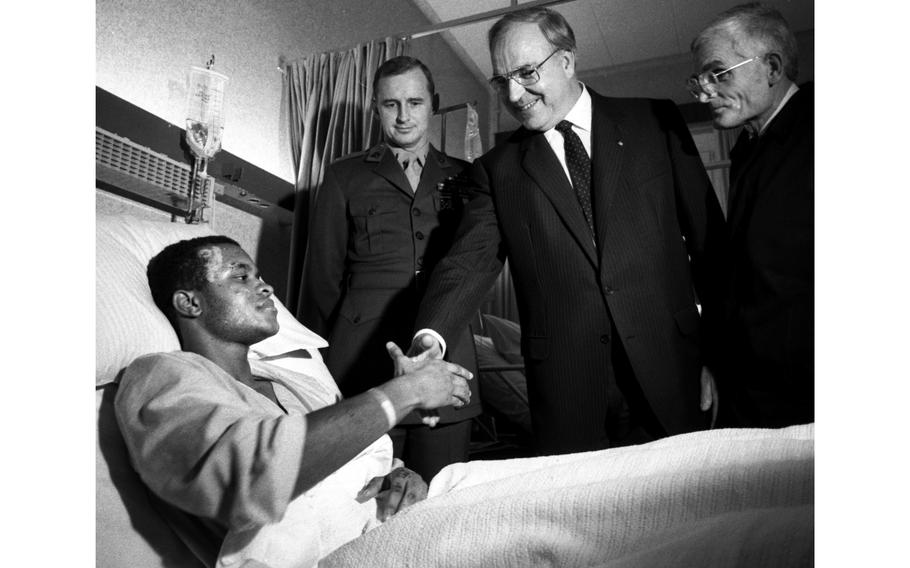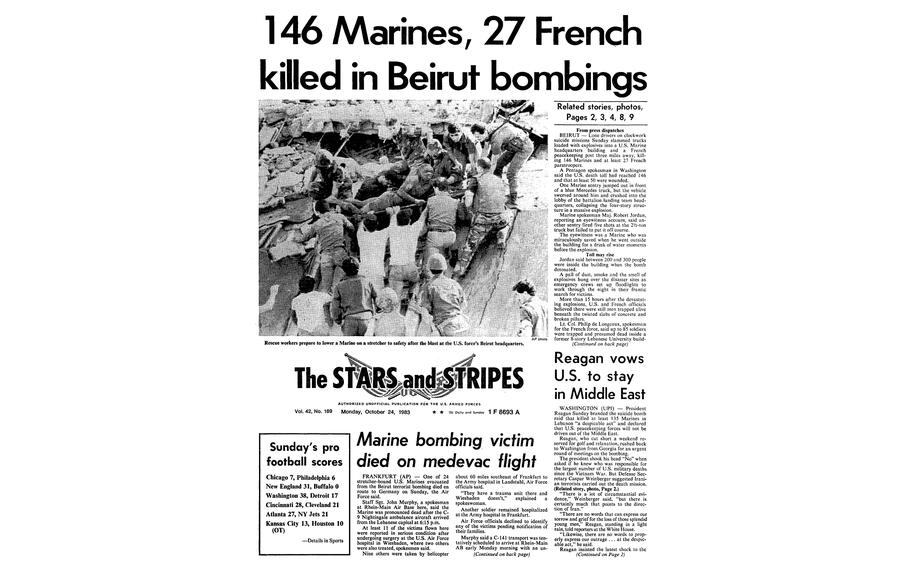
Former German Chancellor Helmut Kohl shakes hands with U.S. Marine Lance Cpl. Kevin Jiggetts, who was wounded in the Oct. 23, 1983, terrorist bombing of a barracks in Beirut, Lebanon. The bombing killed 241 American service members, 220 of them Marines. With Kohl on his visit to the U.S. Air Force hospital in Wiesbaden are Marine liaison officer 1st Lt. Charles Evans and, at right, the chancellor's interpreter. (Stars and Stripes)
Monday marked the 40th anniversary of a suicide bombing on a barracks at the Beirut airport that killed 241 U.S. troops in what was the deadliest day for the Marine Corps since the battle of Iwo Jima in 1945.
The bombing, which killed 220 Marines, 18 sailors and three soldiers, took place during a civil war in Lebanon that killed tens of thousands and left almost a million people displaced.
“In a matter of seconds, a cowardly act of terrorism robbed these American servicemen of their bright futures,” U.S. Ambassador to Lebanon Dorothy Shea said Monday at a memorial in Beirut.
Some 58 French troops and six civilians died in a separate suicide bombing a few minutes afterward.
Monday’s memorial was held amid fears of a new war in Lebanon. Clashes between Israeli forces and Hezbollah in southern Lebanon have increased in recent weeks, in advance of a looming ground offensive by Israel into Gaza.
Unrest in the Middle East after Hamas attacked Israel on Oct. 7, leading to an Israeli aerial bombardment campaign in Gaza, has raised concerns of a regional war between Israel and militant groups tied to Iran, including Hezbollah.
Shea addressed those fears in her speech Monday remembering the Beirut barracks bombing, which she said was conducted with Iran’s support.
“Today, we reject, and the Lebanese people reject, the threats of some to drag Lebanon into a new war,” Shea said.
The service members killed during the Beirut barracks bombing attack 40 years ago were part of an international peacekeeping force. Troops from the U.S., the United Kingdom, France and Italy arrived at the invitation of the Lebanese government in 1982. The move came after Israel invaded southern Lebanon to attack the Palestine Liberation Organization, and during the Lebanese civil war.
American forces gained enemies in the region after the U.S. Navy shelled anti-government militias in support of the Lebanese government, an official Marine Corps history of the event published in 2013 said.
On Oct. 23, 1983, a suicide bomber drove a truck carrying 12,000 pounds of explosives into the U.S. military barracks at the Beirut airport. The building collapsed into rubble almost instantly.
The devastation left survivors in shock, said U.S. Marines who were evacuated to medical hospitals after the attack, in interviews with Stars and Stripes in 1983.
“The first thing I remember was there was a giant concrete slab looming over me, six inches away. It was like a dream, like a coffin. I didn’t know what happened,” said Renard Manley, a lance corporal at the time who was asleep on the fourth floor of the headquarters building.
The U.S. withdrew troops from Lebanon in 1984. After 18 months in the country, 238 Marines had died and 151 had been wounded, the Marine Corps’ official history of the conflict said.
Imad Mughniyeh, a Hezbollah terrorist suspected of involvement in planning the attack, was reportedly killed in 2008 in Damascus, Syria, when his vehicle exploded from a car bomb.

The front page of Stars and Stripes on Oct. 24, 1983, reporting on the bombing of the Marine barracks in Beirut, Lebanon. (Stars and Stripes)